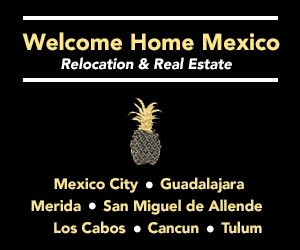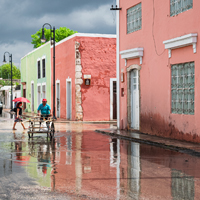Guide to Residency in Mexico
Summary: Looking for guidance on obtaining residency in Mexico? Discover the steps involved and read advice from digital nomads. nomads, and others already in Mexico.
Obtaining a residency visa in Mexico is not always easy, but our Guide to Residency in Mexico gives newcomers an overview of the steps involved and advice from others who have already navigated the process.
- Determine the Type of Residency
- Temporary Resident Visa: For those planning to stay in Mexico for more than 180 days but less than 4 years.
- Permanent Resident Visa: For those who intend to settle permanently in Mexico.
- Prepare the Necessary Documentation
- Passport: Valid and current.
- Visa Application Form: Completed and signed.
- Photographs: Passport-sized photos.
- Financial Records: Bank statements or employment records to prove economic solvency.
- Letter of Intent: Explaining the reason for your residency request.
- Visit a Mexican Consulate
- Find the nearest Mexican consulate (Consulate Directory).
- Make an appointment for a visa interview.
- Submit your visa application along with the required documentation.
- Pay the visa processing fee.
- Enter Mexico
- Once your visa is approved, travel to Mexico.
- Present your visa to the immigration officer upon arrival.
- Complete the Residency Process in Mexico
- Visit the nearest Instituto Nacional de Migración (INM) office within 30 days of arrival in Mexico (INM Website).
- Exchange your visa for a resident card.
- Provide fingerprints and photographs as part of the process.
- Pay the residency card fee.
- Apply for a Tax Number (CURP)
- Visit the Registro Nacional de Población (RENAPO) office or website (CURP Website).
- Fill out the CURP application form.
- Provide a copy of your resident card and passport.
- Receive your Clave Única de Registro de Población (CURP), which is necessary for tax and legal purposes.
- Open a Mexican Bank Account
- Choose a bank with services that suit your needs.
- Visit the bank in person to open an account.
- Provide your passport, resident card, and proof of address.
- Complete the bank's application process.
- Understand Your Healthcare Options
- Research public healthcare insurance like Instituto Mexicano del Seguro Social (IMSS) or private healthcare options.
- Enroll in a healthcare plan that meets your needs.
- Learn About Your Obligations
- Stay informed about visa renewal or status change deadlines.
- Keep your documents up to date, including your resident card and passport.
- Understand your tax obligations as a resident.
What tips do digital nomads and expats have about residency and visas in Mexico?
"This is still a bit of a nightmare. You must apply for your residence from your home country and then there will be a few appointment with immigration. It took us 5 months to get our temp residency and we have to be in Mexico 30 days prior to our 1 year expiration date to renew. Keep you posted on that. At one point we were temp residents but gave it up as we were never in the country longer than 6 months at a time. We travel a lot. But the Mexican govt really wants you to have your residency," commented one expat living in Playa Del Carmen, Mexico.
"The process of applying for a visa in Mexico depends on the type of visa you require. Generally speaking, you will need to submit a visa application form, photographs, your passport, a valid return ticket, and the required visa fee to the Mexican consulate. Additionally, depending on the type of visa you are applying for, you may have to provide additional documentation such as a proof of address, a medical certificate, documentation of sufficient funds, employment records, and proof of relationship to a Mexican citizen. The process of applying for Mexico residency is slightly more involved and documented evidence will often be required from you. In most cases, an application will be required that contains your personal information, orientation for the request, and a copy of your passport. Additionally, you will need to submit evidence of sufficient financial resources, proof of accommodation in Mexico, a medical certificate, a criminal background check, and proof that you have been a resident of Mexico for at least two years. After submitting the application and the required documentation, you will be called for an interview and your documents will be verified. Finally, after being approved, you can collect your residency card," mentioned one member living in Mexico.
"This should be addressed at the immigration office here in Playa. Many come in on a Tourist Visa that is generally given for 180 days. After that, the person has to leave the country and return to hopefully get another Tourist Visa. However, their requirements for getting a Temporary or Permanent Visa are online and are affordable," said an expat in Mexico.
"It has been over 3 years since we went through the process at the Seattle Consulate. They were very specific and they looked at our investment income with social security AND our savings accounts. We provided 2 years of statements downloaded from the brokerage house as well as deposits into our accounts from income. We knew that we would qualify for PR status so it was a breeze. There was no mention about notarization of downloaded documents but we were well organized and made it easier for them. I am unsure about future income from work since we were both retired, but I would think it will be more difficult to convince them that you will have ongoing income from work unless you provide a letter from HR or some other source that shows that you will continue to have income while residing in MX. The best method is to go fully prepared to show your financial qualifications absolutely meet or exceed their requirements," remarked one member living in Mexico.
"Live here with a temp visa FMM you get at the border when you cross, show your passport and cost is about $25. If you purchase property, same thing. Many people that rent, don't bother with getting a resident card, they stay under the radar. The foreigners like me, that work, must have one, either it's temp or perm resident card. In the old days you may have heard them called FM3 and FM2's," said one member living in Mexico.
"The main thing to know is that you must start your residency request outside of Mexico, at a Mexican consulate. Then you have 30 days to present yourself to the Mexico immigrations. There are professional groups that will do all of this for you, for a fee, of course," commented one expat who moved to Mexico.
About the Author
 Joshua Wood, LPC is one of the Founders of Digital Nomad Exchange and serves as Co-President of Expat Exchange. Prior to Expat Exchange and Digital Nomad Exchange, Joshua worked for NBC Cable (MSNBC and CNBC
Primetime). Joshua has a BA from Syracuse and a Master's in Clinical and Counseling Psychology from Fairleigh Dickinson University. Mr. Wood is also a licensed counselor and psychotherapist.
Joshua Wood, LPC is one of the Founders of Digital Nomad Exchange and serves as Co-President of Expat Exchange. Prior to Expat Exchange and Digital Nomad Exchange, Joshua worked for NBC Cable (MSNBC and CNBC
Primetime). Joshua has a BA from Syracuse and a Master's in Clinical and Counseling Psychology from Fairleigh Dickinson University. Mr. Wood is also a licensed counselor and psychotherapist.
Some of Joshua's articles include Pros and Cons of Living in Portugal, 10 Best Places to Live in Ireland and Pros and Cons of Living in Uruguay. Connect with Joshua on LinkedIn.

SJB Global is a top-rated financial advisory firm specializing in expat financial advice worldwide, offering retirement planning & tax-efficient solutions with a regressive fee model.
Learn More
 SJB Global
SJB GlobalSJB Global is a top-rated financial advisory firm specializing in expat financial advice worldwide, offering retirement planning & tax-efficient solutions with a regressive fee model.
Learn More
![]() Mexico Forum
Mexico Forum
Talk with other digital nomads and expats in Mexico on our Mexico forum - meet people, get advice and help others.
![]() Contribute
Contribute
Help others in Mexico by answering questions about the challenges and adventures of living in Mexico.
Digital Nomads in Mexico offer advice about healthcare, hospital visits, emergency rooms visits, finding a doctor and buying health insurance in Mexico.
Advice for people renting and buying real estate in Mexico.

 Mexico
Mexico



